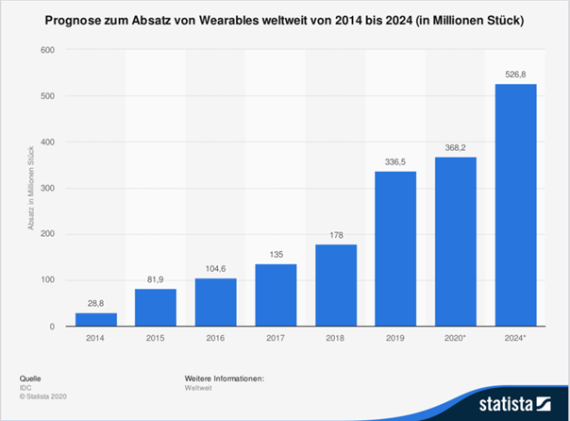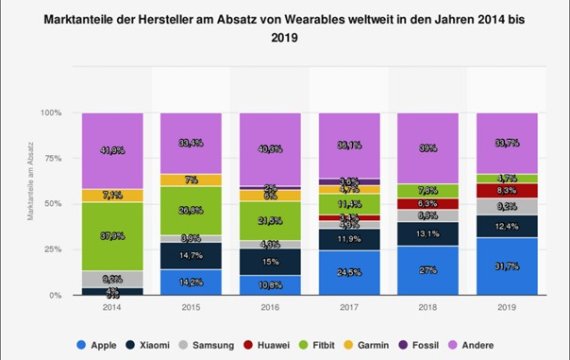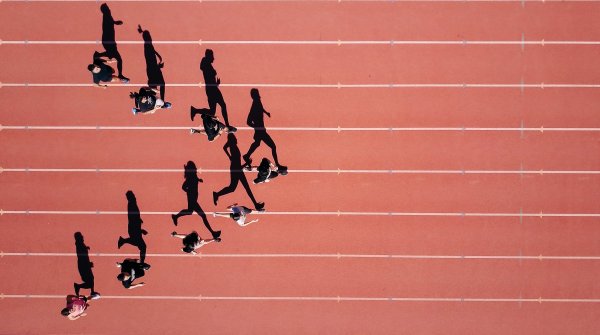
Wearables are still a relatively young phenomenon. In 1997, computer science professor Steven Mann, who is generally regarded as the intellectual father of the small devices, first described his vision of computer systems as a "second brain" on clothing and the body in an article.
In economic terms, smartwatches, fitness trackers and earwear in particular did not become truly relevant until 2014, when 28.8 million units were sold worldwide. Five years later, in 2019, the figure was 336.5 million, more than ten times as many. And by 2024, this figure is expected to rise - at a very conservative estimate - to over 500 million wearables sold.

The smart companions have long since arrived in the mainstream. 71 percent of Germans, for example, own at least one pair of earbuds for listening to music, more and more of which work entirely without cables via Bluetooth. Smartwatches and fitness trackers are also widespread and are generating discussion.
Stiftung Warentest, for example, recently found in a test of smartwatches and fitness trackersthat only three of the 21 devices tested correctly measured pulse rate, distance and calories burned, and were therefore awarded the test grade "Good". So there is still room for improvement. On the other hand, the data from the small sensors is already so relevant that serious scientists want to use it to combat the Corona pandemic.
In addition to resting heart rate, many fitness wristbands and smartwatches also measure heart rate and blood oxygen saturation. They also provide permanent sleep and activity information. This data changes in the case of acute respiratory diseases such as COVID-19. According to Bitkom, researchers - from the Robert Koch Institute (RKI) with its Corona data donation app to the German Center for Cardiovascular Research and Stanford University - are working on models of how this vital data can be used for the early detection of a Corona disease.
The Rockefeller Neuroscience Institute at West Virginia University claims to have achieved spectacular success by matching werable data with AI models: A corona infection can be detected with 90 percent certainty three days before the infected person notices the first symptoms. Such information could decisively slow down the spread of the dangerous virus.
A breakthrough in the fight against Corona would also undoubtedly be the final confirmation that wearables can also be of paramount importance to the healthcare industry. And that is just one of the new trends for the use of wearables. The Fraunhofer Institute for Integrated Systems and Device Technology (IISB), for example, is working on a small sensor called "Elecsa" that constantly collects body data through sweat.
"This allows you to constantly monitor your workout and health - without any annoying chest strap," explains Dr. Klaus Hecker, Managing Director of the Organic and Printed Electronics Association (OE-A), in an interview with ISPO.com: "There are quite a few useful use cases for these new technologies in the medical and health sectors, just as there are in the sports industry."
Printed electronics is what it's called, the integration of wearable sensors into clothing. Here are a few examples:
- Professional clubs and TV companies, for example, use data from smart insoles in athletic shoes that measure distances run, pace, passes played, or use of force.
- Shoe manufacturer Under Armour has built a chip into the sole of its new Hovr running shoe that provides direct feedback on cadence via the "Map my Run" app. This means you can make changes while you're still running.
- Ski boots with sensors that provide permanent information about one's own running style are also already on the market.
- Heated clothing that can be controlled depending on the temperature or via app is becoming a success.
- Intelligent moisture management - the removal of sweat from clothing controlled by sensors - is also gaining in importance.
- There is even Bluetooth underwear that signals to your partner that you want to be together.
In addition to textiles equipped with wearables, energy generation via solar cells in clothing or backpacks and innovative virtual reality swimming or ski goggles are also considered important future markets.
"You could use displays in ski goggles, for example, to show the current speed detected by sensors or guide people to the lift where the fewest people are waiting in line," Klaus Hecker dreams. The potential applications of wearables are therefore almost limitless - eleven percent of smartwatch owners already use their wrist wonder to control smart home applications, for example.
The Corona pandemic is further accelerating this trend toward digitization. Even before the pandemic, sales in the wearables market were forecast to rise from $52 billion this year to $63 billion in 2021. Among the major players, significant changes have taken place in recent years.
Fitbit - still the clear market leader at the start of the wearable boom in 2014 with a 37.9 percent share - is on its way to irrelevance. Instead, Apple is now number 1 and is steadily expanding its top position. Samsung and Huawei have also been able to massively increase their market shares in recent years. An overview of 2019 (source Statista):
- Apple (market share 2019: 31.7 percent).
- Xiaomi (12.4 percent)
- Samsung (9.2 percent)
- Huawei (8.3 percent)




